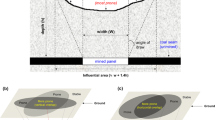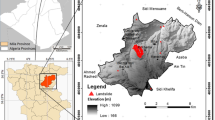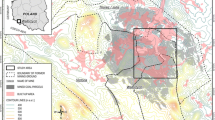Abstract
Ground subsidence around abandoned underground coal mines can cause much loss of life and property. We analyze factors that can affect ground subsidence around abandoned mines in Jeongahm in Kangwon-do by sensitivity analysis in geographic information system (GIS). Spatial data for the subsidence area, topography and geology and various ground engineering data were collected and used to make a factor raster database for a ground subsidence hazard map. To determine the importance of extracted subsidence-related factors, frequency ratio model and sensitivity analysis were employed. Sensitivity analysis is a method for comparing the combined effects of all factors except one. Sensitivity analysis and its verification showed that using all factors provided 91.61% accuracy. The best accuracy was achieved by not considering the groundwater depth (92.77%) and the worst by not considering the lineament (85.42%). The results show that the distance from the lineament and the distance from the drift highly affected the occurrence of ground subsidence, and the groundwater depth, land use and rock mass rating had the least effects. Thus, we determined causes of ground subsidence in the study area and this information could help in the prediction of ground subsidence in other areas.









Similar content being viewed by others
References
Ambrožič T, Turk G (2003) Prediction of subsidence due to underground mining by artificial neural networks. Comput Geosci 29(5):627–637
Arhonditsis GB, Brett MT (2005) Eutrophication model for Lake Washington (USA): Part I. Model description and sensitivity analysis. Ecol Model 187:140–178
Choi J-K, Kim K-D, Lee S, Won J-S (2010) Application of a fuzzy operator to susceptibility estimations of coal mine subsidence in Taebaek City, Korea. Environ Earth Sci 59(5):1009–1022
Coal Industry Promotion Board (CIPB) (1996) Fundamental investigation report of the stability test for Hwajeon. Coal Industry Promotion Board, Seoul, 96-04, pp 1–549
Coal Industry Promotion Board (CIPB) (1997) A study on the mechanism of subsidence over abandoned mine area and the construction method of subsidence prevention. Coal Industry Promotion Board, Seoul, 97-06, pp 1–67
Joo WH, Jang YS, Kim YI (1998) Sensitivity analysis of the leachate level of a landfill to hydraulic properties of cover soil and waste. J Kor Soc Groundw Environ 5(2):110–115
Kim KD, Lee S, Oh HJ, Choi JK, Won JS (2006) Assessment of ground subsidence hazard near an abandoned underground coal mine using GIS. Environ Geol 50(8):1183–1191
Kim KD, Lee S, Oh HJ (2009) Prediction of ground subsidence in Samcheok City, Korea using artificial neural networks and GIS. Environ Geol 58(1):61–70
Lee S, Dan NT (2005) Probabilistic landslide susceptibility mapping in the Lai Chau province of Vietnam: focus on the relationship between tectonic fractures and landslides. Environ Geol 48:778–787
Lee S, Talib JA (2005) Probabilistic landslide susceptibility and factor effect analysis. Environ Geol 47:982–990
Lee S, Oh H-J, Kim K-D (2010) Statistical spatial modeling of ground subsidence hazard near an abandoned underground coal mine. Disaster Adv 3(1):11–23
Oh H-J, Lee S (2010) Assessment of ground subsidence using GIS and the weights-of-evidence model. Eng Geol. doi:10.1016/j.enggeo.2010.06.015
Quanyuan W, Jiewu P, Shanzhong Q, Yiping L, Congcong H, Tingxiang L, Limei H (2009) Impacts of coal mining subsidence on the surface landscape in Longkou city, Shandong Province of China. Environ Earth Sci 59(4):783–791
The Geological Society of Korea (1999) Geology of Korea. Sigma Press, Seoul
Turer D, Nefeslioglu HA, Zorlu K, Gokceoglu C (2008) Assessment of geo-environmental problems of the Zonguldak province (NW Turkey). Environ Geol 55(5):1001–1014
Waltham AC (1989) Ground subsidence. Blackie & Son Ltd, New York, pp 49–97
Zahiri H, Palamara DR, Flentje P, Brassington GM, Baafi E (2006) A GIS-based weights-of-evidence model for mapping cliff instabilities associated with mine subsidence. Environ Geol 51(3):377–386
Acknowledgments
The authors thank the Coal Industry Promotion Board for providing whole investigation reports and basic GIS database. This research was supported by the Basic Research Project of the Korea Institute of Geoscience and Mineral Resources (KIGAM) funded by the Ministry of Knowledge and Economy of Korea.
Author information
Authors and Affiliations
Corresponding author
Rights and permissions
About this article
Cite this article
Oh, HJ., Ahn, SC., Choi, JK. et al. Sensitivity analysis for the GIS-based mapping of the ground subsidence hazard near abandoned underground coal mines. Environ Earth Sci 64, 347–358 (2011). https://doi.org/10.1007/s12665-010-0855-1
Received:
Accepted:
Published:
Issue Date:
DOI: https://doi.org/10.1007/s12665-010-0855-1




